Prognostic Value of CAV1 and CAV2 in Head and Neck Squamous Cell Carcinoma
Abstract
1. Background
2. Methods
2.1. CancerSEA Database Analysis
2.2. Comparison of CAV1 and CAV2 Gene Transcripts in HNSCC
2.3. Statistics and Survival Analysis
2.4. Identification of CAV1/CAV2 Co-Expressed Genes
2.5. Protein-Protein Interaction (PPI) Network Analysis
2.6. Gene Set Enrichment Analysis (GSEA)
2.7. Using TIMER for Tumor-Infiltrating Immune Cell Exploration
2.8. CAV-Drug Interaction Network Analysis
2.9. IHC
3. Results
3.1. Relevant Clinical Feature
3.1.1. Functions of CAV1 and CAV2 in a Single HNSCC
3.1.2. CAV1 and CAV2 mRNAs Are Significantly Upregulated in HNSCC Tissues
3.1.3. CAV1 and CAV2 mRNA Expression Levels Were Associated with Multiple Clinical Features
3.1.4. Statistics and Survival Analysis
3.1.5. CAV1 and CAV2 mRNA Expression Levels Were Correlated with Primary Tumor Sites
3.1.6. CAV1 and CAV2 mRNA Expression Levels Were Associated with HPV Status
3.2. Molecular Interaction
3.2.1. PPI Co-Expression
3.2.2. GSEA
3.2.3. Using TIMER for Tumor-Infiltrating Immune Cell Exploration
3.2.4. CAV-Drug Interaction Network Analysis
3.3. Experimental Validation
4. Discussion
5. Conclusions
Supplementary Materials
Author Contributions
Funding
Institutional Review Board Statement
Informed Consent Statement
Data Availability Statement
Acknowledgments
Conflicts of Interest
Abbreviations
| Head and neck squamous cell carcinoma | HNSCC |
| Gene set enrichment analysis | GSEA |
| Comparative Toxicogenomics Database | CTD |
| Immunohistochemistry | IHC |
| Caveolin-1 | CAV1 |
| Caveolin-2 | CAV2 |
| The Cancer Genome Atlas | TCGA |
| Genotype-Tissue Expression | GTEx |
| Gene Ontology | GO |
| Transcript per million | TPM |
| Overall survival | OS |
| Disease-specific survival | DSS |
| Progression-free interval | PFI |
| Protein-protein interaction | PPI |
| Tissue microarray | TMA |
References
- Bray, F.; Ferlay, J.; Soerjomataram, I.; Siegel, R.L.; Torre, L.A.; Jemal, A. Global cancer statistics 2018: GLOBOCAN estimates of incidence and mortality worldwide for 36 cancers in 185 countries. CA Cancer J. Clin. 2018, 68, 394–424. [Google Scholar] [CrossRef] [PubMed]
- Johnson, D.E.; Burtness, B.; Leemans, C.R.; Lui, V.W.Y.; Bauman, J.E.; Grandis, J.R. Head and neck squamous cell carcinoma. Nat. Rev. Dis. Primers 2020, 6, 92. [Google Scholar] [CrossRef] [PubMed]
- Allen, C.T.; Law, J.H.; Dunn, G.P.; Uppaluri, R. Emerging insights into head and neck cancer metastasis. Head Neck 2013, 35, 1669–1678. [Google Scholar] [CrossRef] [PubMed]
- Cho, W.J.; Chow, A.K.; Schulz, R.; Daniel, E.E. Matrix metalloproteinase-2, caveolins, focal adhesion kinase and c-Kit in cells of the mouse myocardium. J. Cell. Mol. Med. 2007, 11, 1069–1086. [Google Scholar] [CrossRef] [PubMed]
- Nohata, N.; Hanazawa, T.; Kikkawa, N.; Mutallip, M.; Fujimura, L.; Yoshino, H.; Kawakami, K.; Chiyomaru, T.; Enokida, H.; Nakagawa, M.; et al. Caveolin-1 mediates tumor cell migration and invasion and its regulation by miR-133a in head and neck squamous cell carcinoma. Int. J. Oncol. 2011, 38, 209–217. [Google Scholar]
- Fu, P.; Chen, F.-C.; Pan, Q.; Zhao, X.; Zhao, C.; Cho, W.C.-S.; Chen, H.-L. The different functions and clinical significances of caveolin-1 in human adenocarcinoma and squamous cell carcinoma. OncoTargets Ther. 2017, 10, 819–835. [Google Scholar] [CrossRef]
- Subramanian, A.; Tamayo, P.; Mootha, V.K.; Mukherjee, S.; Ebert, B.L.; Gillette, M.A.; Paulovich, A.; Pomeroy, S.L.; Golub, T.R.; Lander, E.S.; et al. Gene set enrichment analysis: A knowledge-based approach for interpreting genome-wide expression profiles. Proc. Natl. Acad. Sci. USA 2005, 102, 15545–15550. [Google Scholar] [CrossRef]
- Li, T.; Fan, J.; Wang, B.; Traugh, N.; Chen, Q.; Liu, J.S.; Li, B.; Liu, X.S. TIMER: A Web Server for Comprehensive Analysis of Tumor-Infiltrating Immune Cells. Cancer Res. 2017, 77, e108–e110. [Google Scholar] [CrossRef]
- Ang, K.K.; Harris, J.; Wheeler, R.; Weber, R.; Rosenthal, D.I.; Nguyen-Tân, P.F.; Westra, W.H.; Chung, C.H.; Jordan, R.C.; Lu, C.; et al. Human Papillomavirus and Survival of Patients with Oropharyngeal Cancer. N. Engl. J. Med. 2010, 363, 24–35. [Google Scholar] [CrossRef]
- Klussmann, J.P.; Mooren, J.J.; Lehnen, M.; Claessen, S.M.; Stenner, M.; Huebbers, C.U.; Weissenborn, S.J.; Wedemeyer, I.; Preuss, S.F.; Straetmans, J.; et al. Genetic Signatures of HPV-related and Unrelated Oropharyngeal Carcinoma and Their Prognostic Implications. Clin. Cancer Res. 2009, 15, 1779–1786. [Google Scholar] [CrossRef]
- Wang, Z.; Sturgis, E.M.; Guo, W.; Song, X.; Zhang, F.; Xu, L.; Wei, Q.; Li, G. Association of Combined p73 and p53 Genetic Variants with Tumor HPV16-Positive Oropharyngeal Cancer. PLoS ONE 2012, 7, e35522. [Google Scholar] [CrossRef]
- Partlová, S.; Boucek, J.; Kloudová, K.; Lukešová, E.; Zábrodský, M.; Grega, M.; Fučíková, J.; Truxová, I.; Tachezy, R.; Špíšek, R.; et al. Distinct patterns of intratumoral immune cell infiltrates in patients with HPV-associated compared to non-virally induced head and neck squamous cell carcinoma. Oncoimmunology 2015, 4, e965570. [Google Scholar] [CrossRef]
- Eke, I.; Cordes, N. Focal adhesion signaling and therapy resistance in cancer. Semin. Cancer Biol. 2015, 31, 65–75. [Google Scholar] [CrossRef]
- Catalgol, B. Proteasome and Cancer. Prog. Mol. Biol. Transl. Sci. 2012, 109, 277–293. [Google Scholar] [CrossRef]
- Rousseau, A.; Bertolotti, A. Regulation of proteasome assembly and activity in health and disease. Nat. Rev. Mol. Cell Biol. 2018, 19, 697–712. [Google Scholar] [CrossRef]
- Ferlay, J.E.A. Global Cancer Observatory: Cancer Today., Lyon, France: International Agency for Research on Cancer. 2018. IARC. Available online: https://gco.iarc.fr/today (accessed on 1 September 2021).
- Daassi, D.; Mahoney, K.M.; Freeman, G.J. The importance of exosomal PDL1 in tumour immune evasion. Nat. Rev. Immunol. 2020, 20, 209–215. [Google Scholar] [CrossRef]
- Viet, C.T.; Yu, G.; Asam, K.; Thomas, C.M.; Yoon, A.J.; Wongworawat, Y.C.; Haghighiabyaneh, M.; Kilkuts, C.A.; McGue, C.M.; Couey, M.A.; et al. The REASON score: An epigenetic and clinicopathologic score to predict risk of poor survival in patients with early stage oral squamous cell carcinoma. Biomark. Res. 2021, 9, 42. [Google Scholar] [CrossRef]
- Lavie, Y.; Fiucci, G.; Liscovitch, M. Upregulation of caveolin in multidrug resistant cancer cells: Functional implications. Adv. Drug Deliv. Rev. 2001, 49, 317–323. [Google Scholar] [CrossRef]
- Vykoukal, J.; Fahrmann, J.F.; Gregg, J.R.; Tang, Z.; Basourakos, S.; Irajizad, E.; Park, S.; Yang, G.; Creighton, C.J.; Fleury, A.; et al. Caveolin-1-mediated sphingolipid oncometabolism underlies a metabolic vulnerability of prostate cancer. Nat. Commun. 2020, 11, 4279. [Google Scholar] [CrossRef]
- Carver, L.A.; Schnitzer, J.E. Caveolae: Mining little caves for new cancer targets. Nat. Rev. Cancer 2003, 3, 571–581. [Google Scholar] [CrossRef]
- Ando, T.; Ishiguro, H.; Kimura, M.; Mitsui, A.; Mori, Y.; Sugito, N.; Tomoda, K.; Mori, R.; Harada, K.; Katada, T.; et al. The overexpression of caveolin-1 and caveolin-2 correlates with a poor prognosis and tumor progression in esophageal squamous cell carcinoma. Oncol. Rep. 2007, 18, 601–609. [Google Scholar] [CrossRef] [PubMed]
- Ma, X.; Liu, L.; Nie, W.; Li, Y.; Zhang, B.; Zhang, J.; Zhou, R. Prognostic role of caveolin in breast cancer: A meta-analysis. Breast 2013, 22, 462–469. [Google Scholar] [CrossRef] [PubMed]
- Liang, C.; Shi, S.; Meng, Q.; Liang, D.; Hua, J.; Qin, Y.; Zhang, B.; Xu, J.; Ni, Q.; Yu, X. MiR-29a, targeting caveolin 2 expression, is responsible for limitation of pancreatic cancer metastasis in patients with normal level of serum CA125. Int. J. Cancer 2018, 143, 2919–2931. [Google Scholar] [CrossRef] [PubMed]
- Zhu, Y.; Tian, J.; Peng, X.; Wang, X.; Yang, N.; Ying, P.; Wang, H.; Li, B.; Li, Y.; Zhang, M.; et al. A genetic variant conferred high expression of CAV2 promotes pancreatic cancer progression and associates with poor prognosis. Eur. J. Cancer 2021, 151, 94–105. [Google Scholar] [CrossRef]
- Gauthier, J.; Vincent, A.T.; Charette, S.J.; Derome, N. A brief history of bioinformatics. Brief. Bioinform. 2019, 20, 1981–1996. [Google Scholar] [CrossRef]

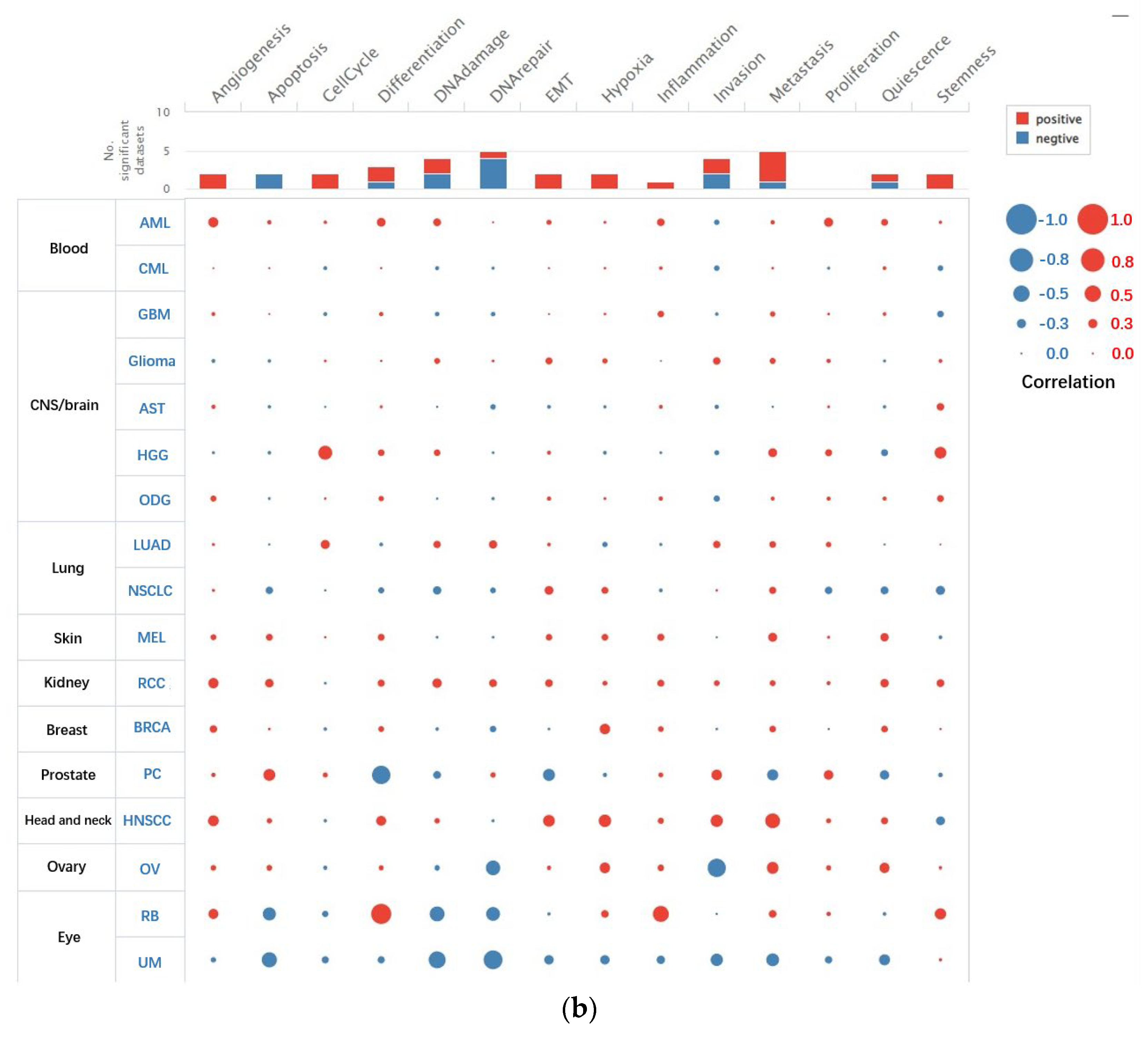
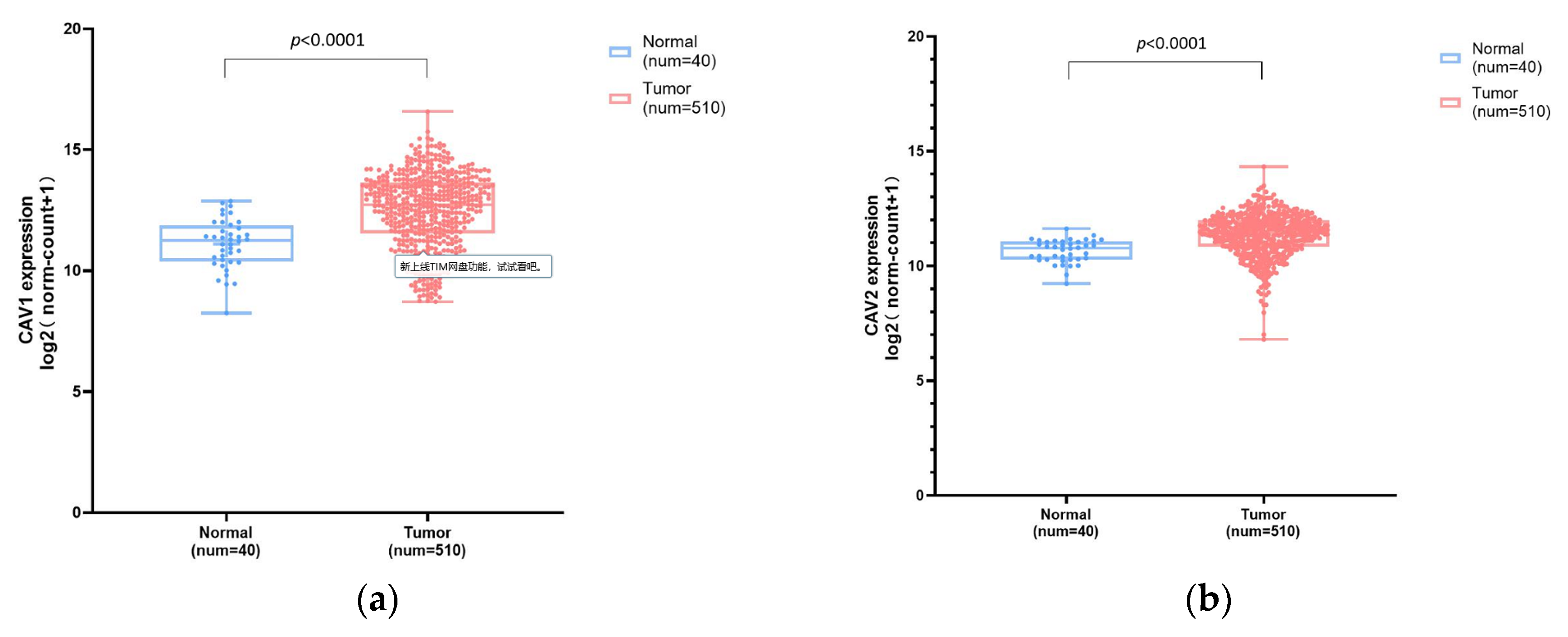
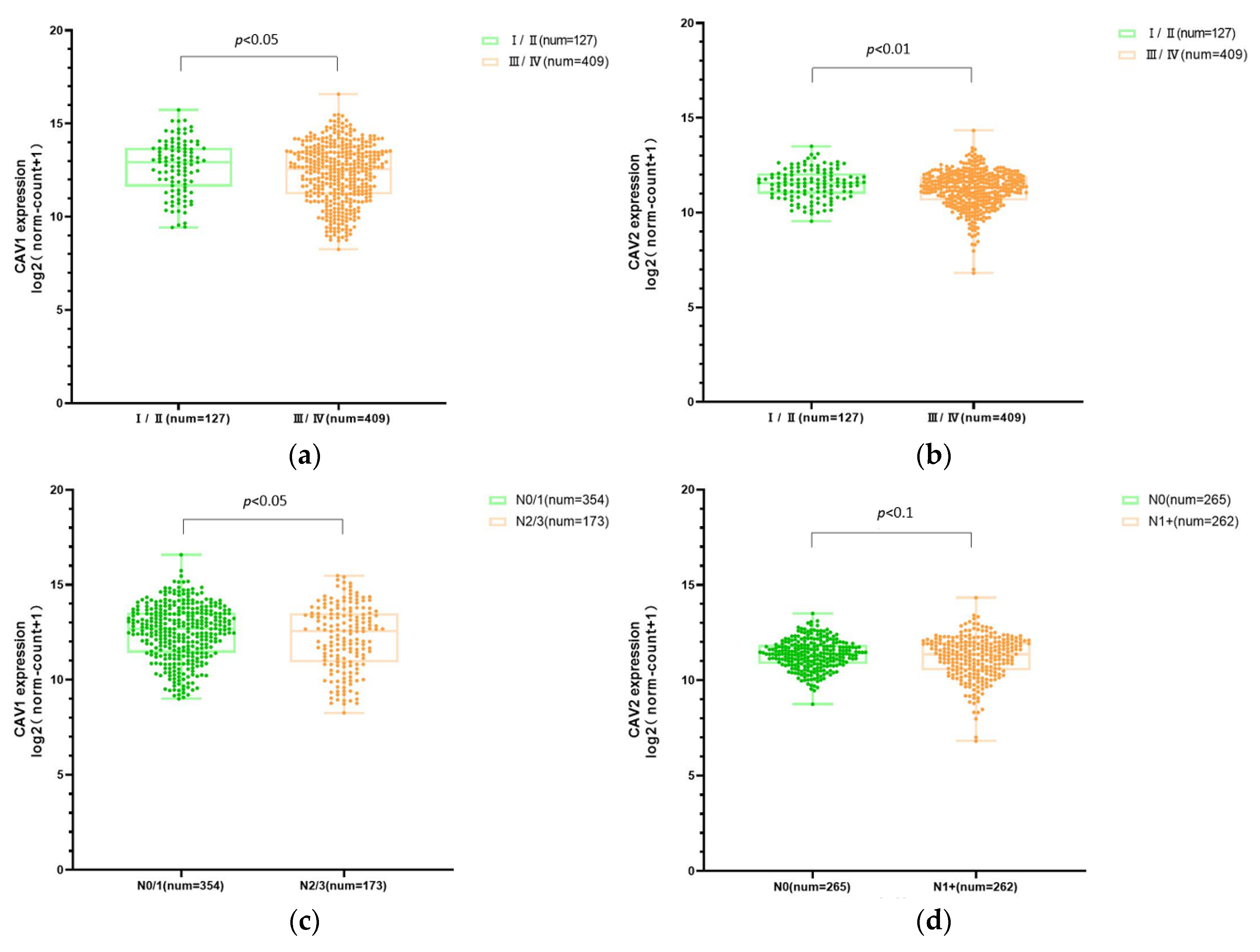

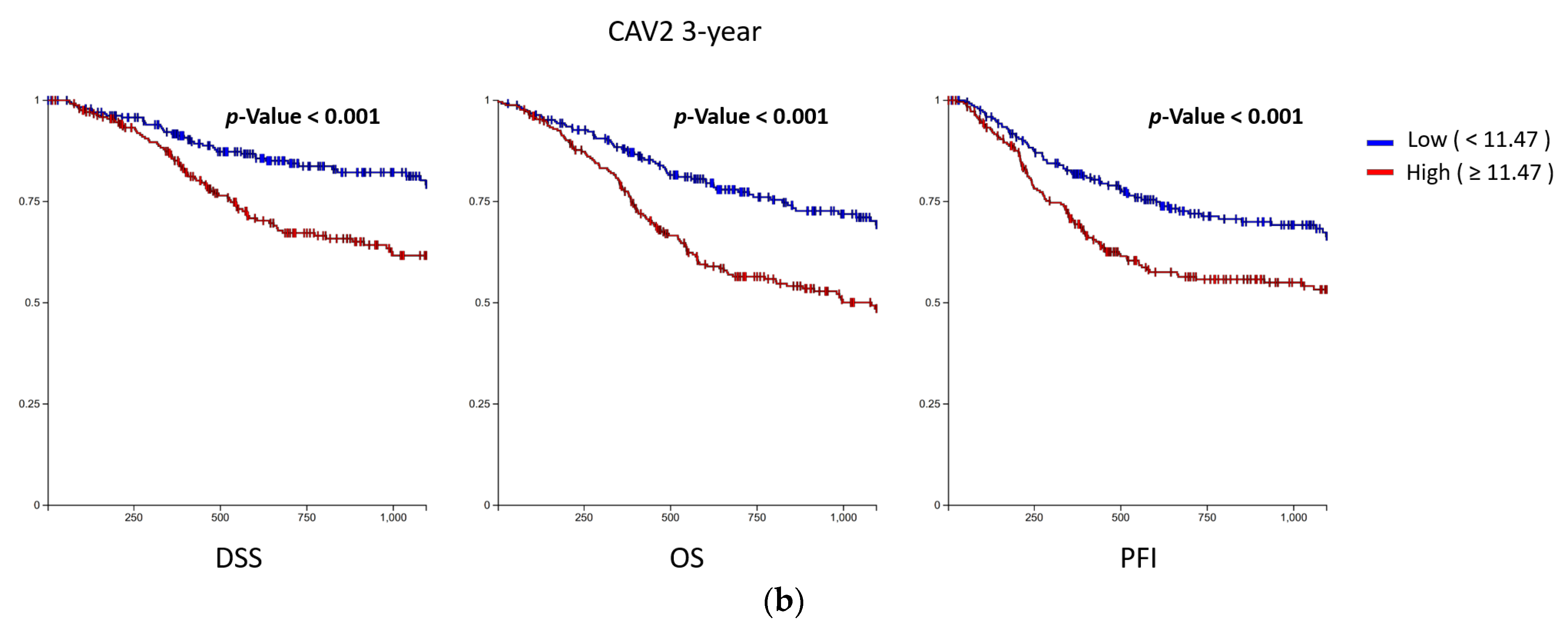


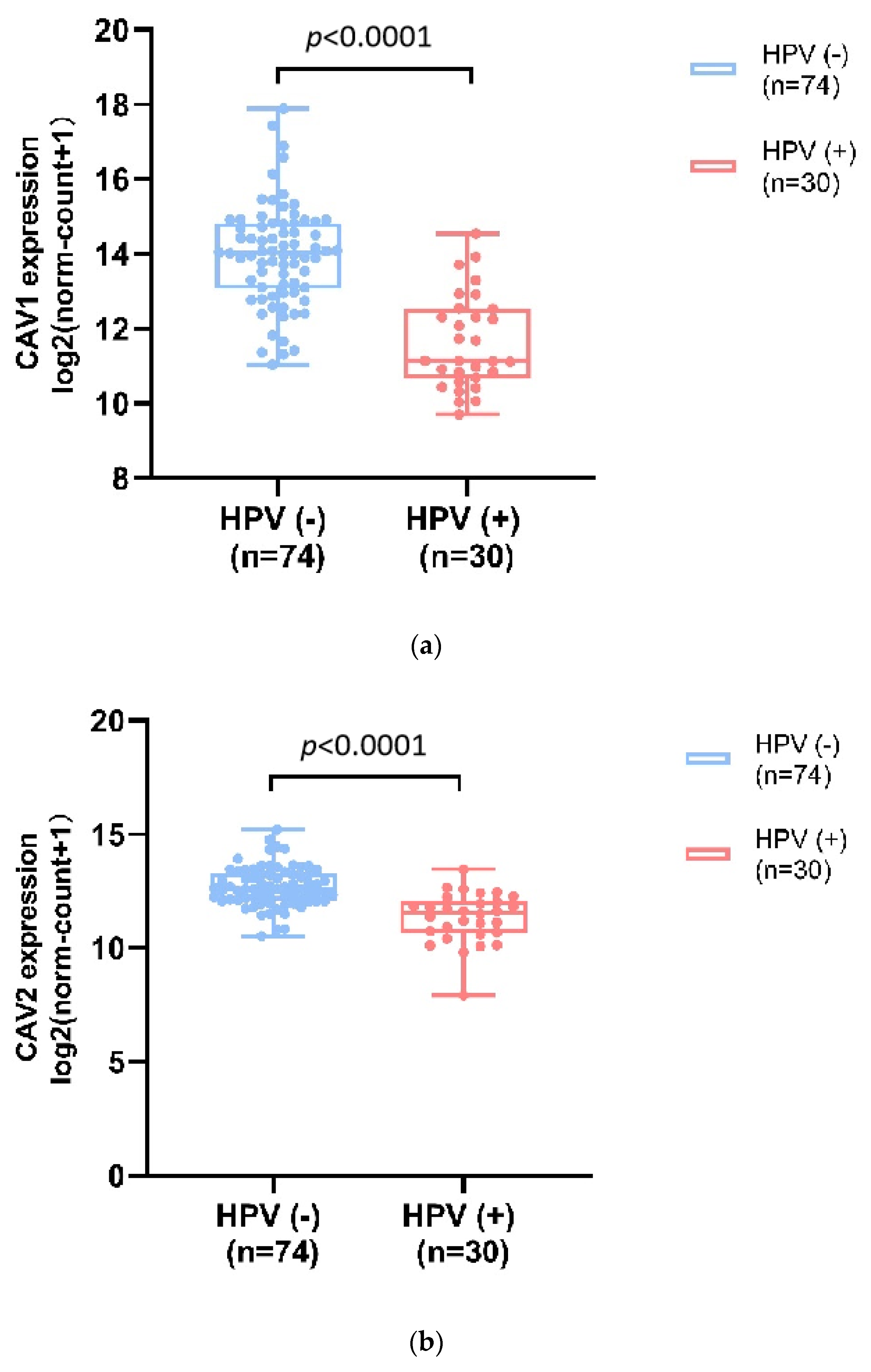

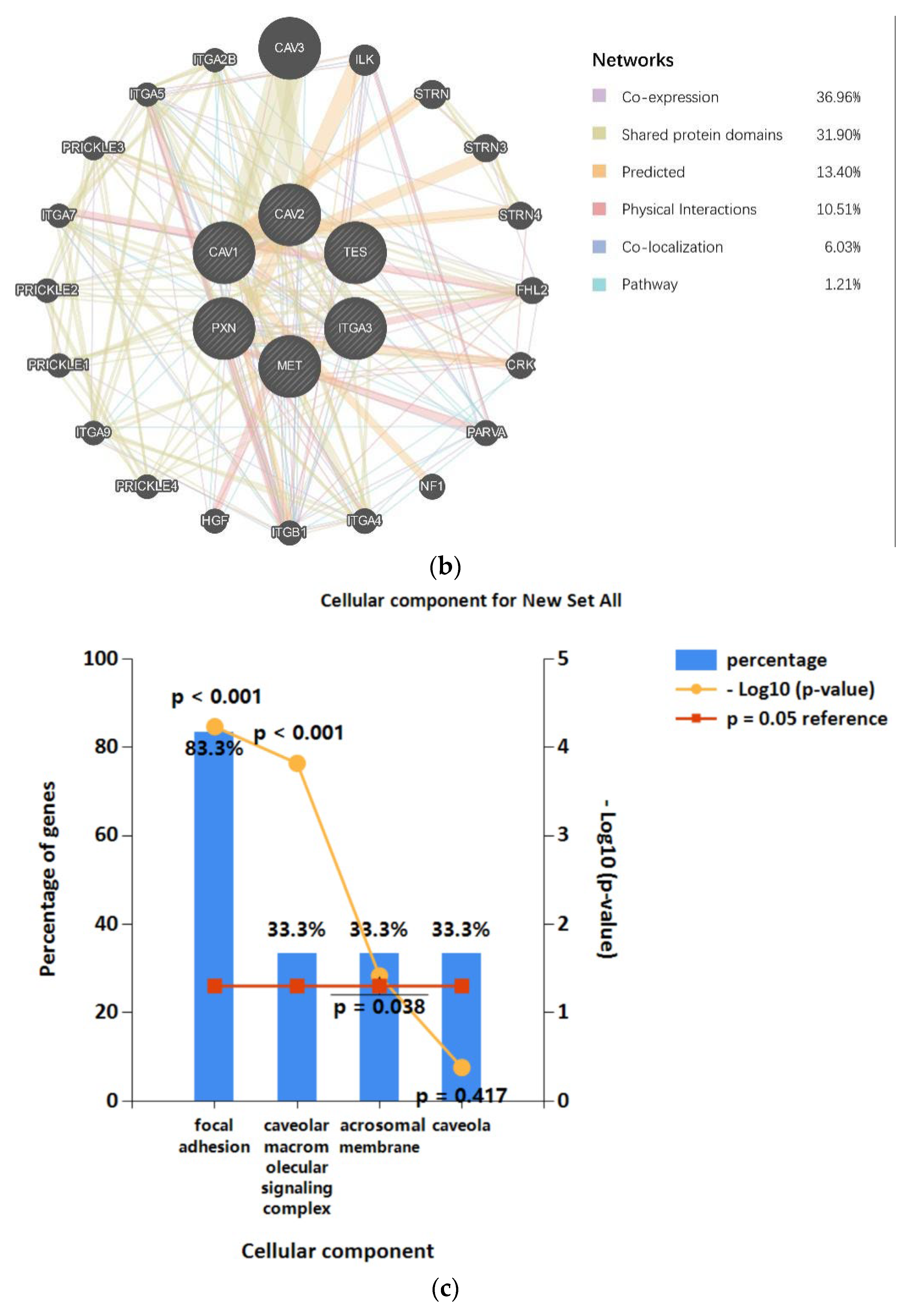
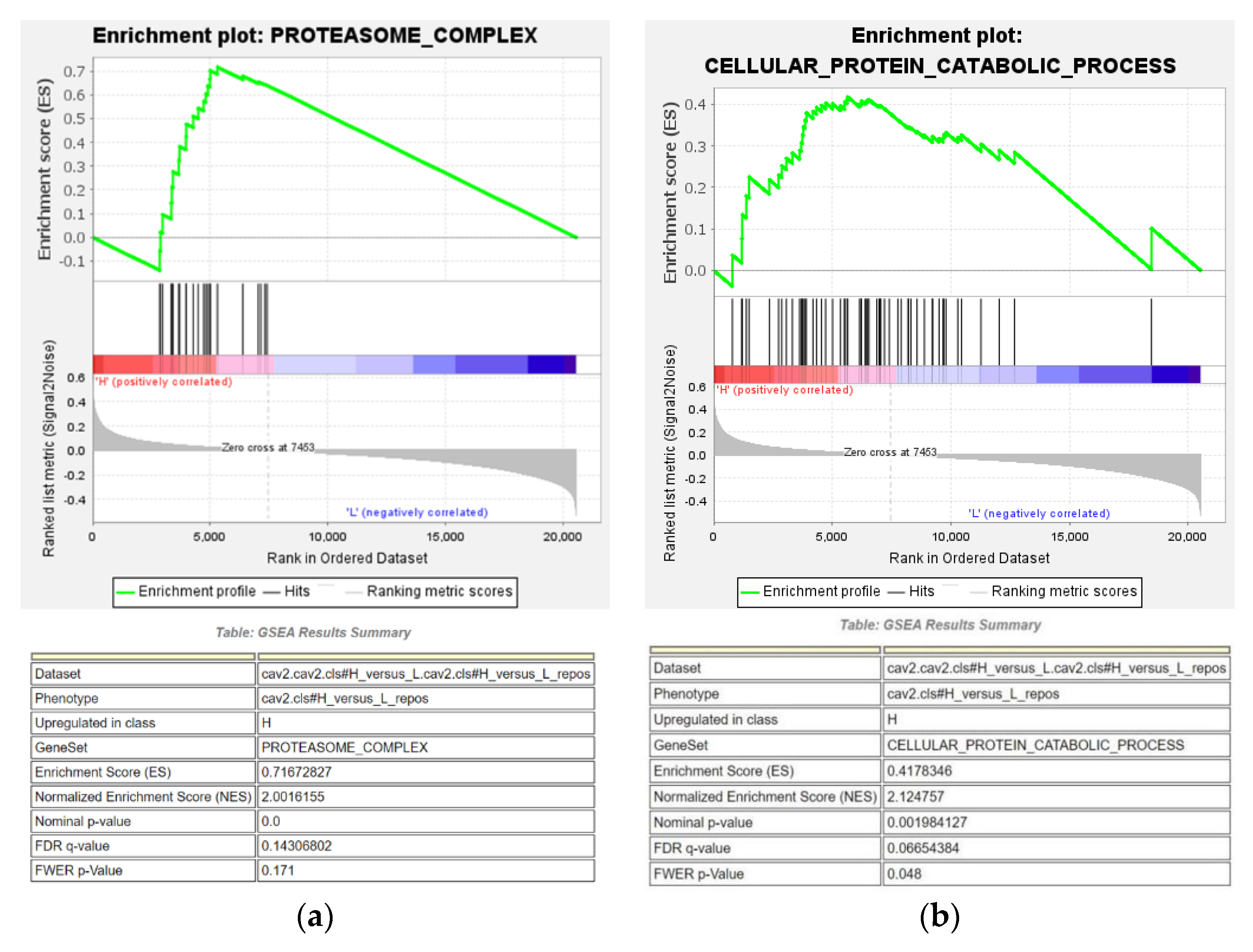


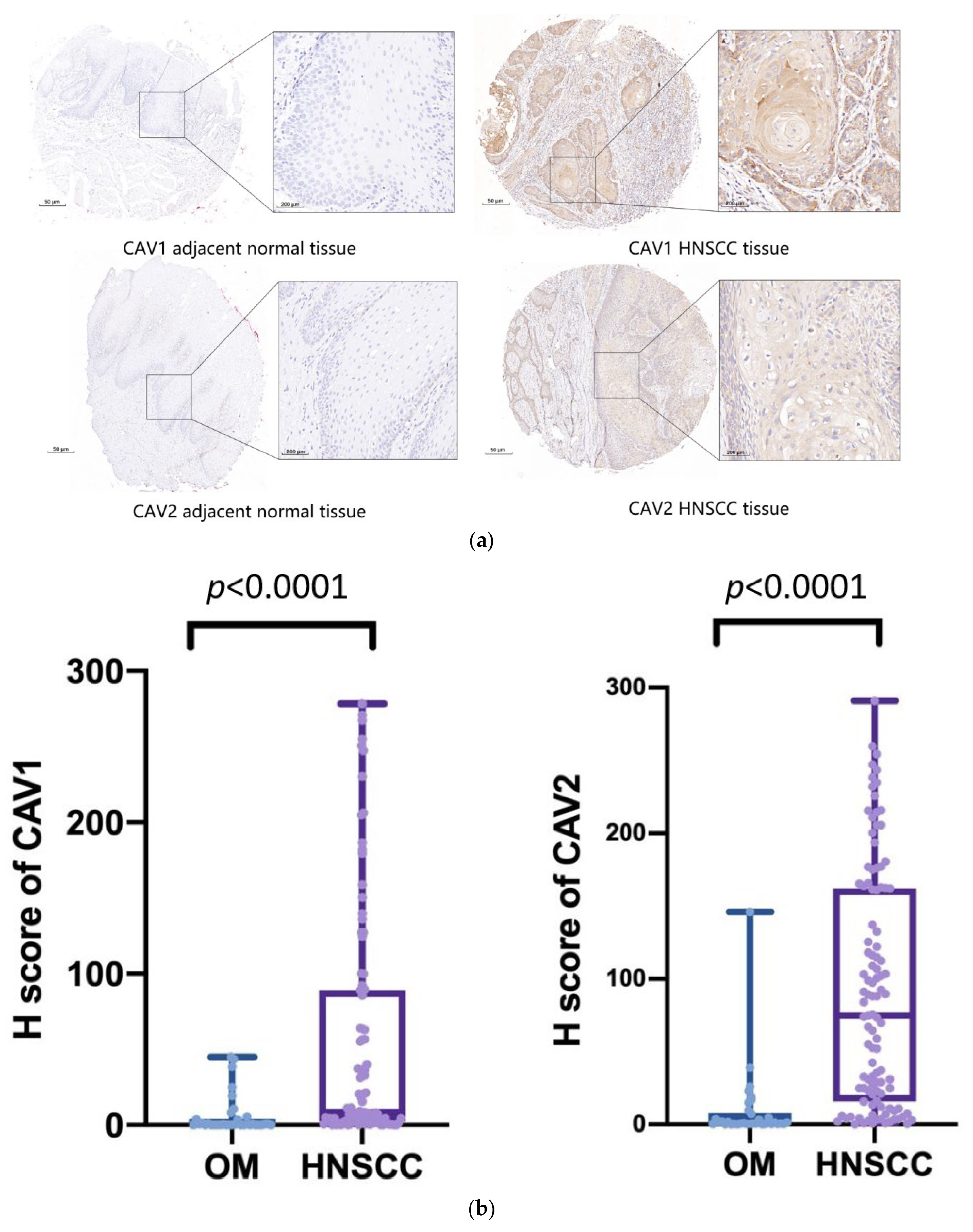
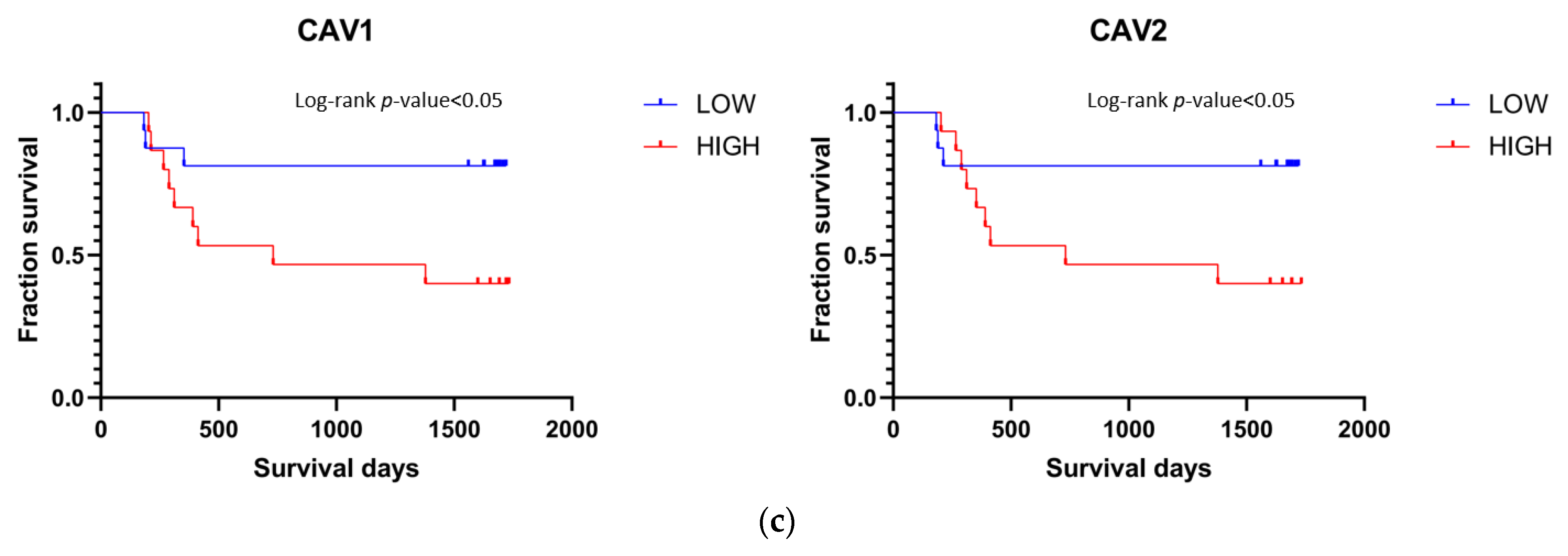
| CAV1 Expression | CAV2 Expression | ||||||
|---|---|---|---|---|---|---|---|
| Parameters | High(N = 255) | Low(N = 255) | p-Value | High(N = 258) | Low(N = 252) | p-Value | |
| Age | Mean ± SD | 61.19 ± 12.452 | 60.88 ± 11.091 | 0.769 | 61.67 ± 12.394 | 60.38 ± 11.098 | 0.218 |
| No data | 1 | 0 | 0 | 1 | |||
| Gender | Female | 76 | 57 | 0.069 | 79 | 54 | 0.020 |
| Male | 179 | 198 | 179 | 198 | |||
| Alcohol history documented | No | 75 | 82 | 0.563 | 82 | 75 | 0.773 |
| Yes | 175 | 168 | 173 | 170 | |||
| No data | 5 | 5 | 3 | 7 | |||
| Tobacco smoking history | No | 62 | 53 | 0.395 | 61 | 54 | 0.526 |
| Yes | 187 | 196 | 190 | 193 | |||
| No data | 6 | 6 | 7 | 5 | |||
| Radiation therapy | No | 91 | 65 | 0.038 | 86 | 70 | 0.165 |
| Yes | 139 | 151 | 139 | 151 | |||
| No data | 25 | 39 | 33 | 31 | |||
| Neoplasm histologic grade | G1/G2 | 193 | 169 | 0.104 | 186 | 176 | 1.000 |
| G3/G4 | 59 | 73 | 68 | 64 | |||
| No data | 3 | 13 | 4 | 12 | |||
| Clinical T | T1/T2 | 89 | 92 | 0.852 | 90 | 91 | 0.780 |
| T3/T4 | 158 | 155 | 160 | 153 | |||
| No data | 8 | 8 | 8 | 8 | |||
| Clinical N | N0 | 120 | 117 | 0.717 | 120 | 117 | 0.857 |
| N1/N2/N3 | 122 | 129 | 125 | 126 | |||
| No data | 13 | 9 | 13 | 9 | |||
| Clinical stage | Stage I/Stage II | 65 | 48 | 0.069 | 68 | 45 | 0.019 |
| Stage III/Stage IV | 182 | 201 | 182 | 201 | |||
| No data | 8 | 6 | 8 | 6 | |||
| Pathological stage | Stage I/Stage II | 58 | 40 | 0.169 | 57 | 41 | 0.421 |
| Stage III/Stage IV | 174 | 167 | 181 | 160 | |||
| No data | 23 | 48 | 20 | 51 | |||
| Univariate Analysis | Multivariate Analysis | |||||||
|---|---|---|---|---|---|---|---|---|
| HR | HR.95L | HR.95H | p-Value | HR | HR.95L | HR.95H | p-Value | |
| DSS | ||||||||
| CAV1 | 1.156 | 1.026 | 1.303 | 0.017 | 0.849 | 0.629 | 1.147 | 0.287 |
| CAV2 | 1.321 | 1.076 | 1.620 | 0.008 | 1.891 | 1.145 | 3.124 | 0.013 |
| Age | 1.010 | 0.994 | 1.026 | 0.238 | 1.022 | 0.998 | 1.045 | 0.068 |
| Gender | 1.057 | 0.707 | 1.579 | 0.788 | 0.847 | 0.475 | 1.512 | 0.575 |
| Alcohol history documented | 1.216 | 0.816 | 1.811 | 0.337 | 1.327 | 0.774 | 2.275 | 0.304 |
| Tobacco smoking history | 1.085 | 0.708 | 1.664 | 0.707 | 0.776 | 0.437 | 1.375 | 0.385 |
| Radiation therapy | 0.783 | 0.513 | 1.194 | 0.256 | 0.518 | 0.288 | 0.932 | 0.028 |
| Neoplasm histologic grade | 1.043 | 0.806 | 1.349 | 0.751 | 1.166 | 0.795 | 1.710 | 0.431 |
| Clinical T | 1.103 | 0.918 | 1.326 | 0.296 | 1.096 | 0.711 | 1.689 | 0.677 |
| Clinical N | 1.258 | 1.042 | 1.520 | 0.017 | 1.494 | 1.051 | 2.125 | 0.025 |
| Clinical stage | 1.071 | 0.879 | 1.305 | 0.497 | 0.622 | 0.349 | 1.110 | 0.108 |
| Pathologic stage | 1.550 | 1.210 | 1.987 | 0.001 | 2.535 | 1.620 | 3.966 | 0.000 |
| Tumor site (sorted by CAV1 expression level) | 1.039 | 0.992 | 1.089 | 0.101 | 0.995 | 0.849 | 1.165 | 0.946 |
| Tumor site (sorted by CAV2 expression level) | 1.050 | 0.997 | 1.105 | 0.063 | 1.054 | 0.890 | 1.249 | 0.539 |
| OS | ||||||||
| CAV1 | 1.129 | 1.029 | 1.238 | 0.010 | 0.881 | 0.700 | 1.108 | 0.280 |
| CAV2 | 1.252 | 1.069 | 1.465 | 0.005 | 1.617 | 1.089 | 2.400 | 0.017 |
| Age | 1.025 | 1.012 | 1.038 | 0.000 | 1.026 | 1.008 | 1.045 | 0.004 |
| Gender | 1.332 | 0.994 | 1.786 | 0.055 | 0.964 | 0.624 | 1.491 | 0.870 |
| Alcohol history documented | 0.934 | 0.699 | 1.249 | 0.646 | 1.033 | 0.696 | 1.533 | 0.873 |
| Tobacco smoking history | 1.141 | 0.809 | 1.609 | 0.453 | 0.894 | 0.570 | 1.402 | 0.626 |
| Radiation therapy | 0.609 | 0.446 | 0.831 | 0.002 | 0.443 | 0.288 | 0.681 | 0.000 |
| Neoplasm histologic grade | 1.012 | 0.831 | 1.233 | 0.903 | 1.096 | 0.829 | 1.449 | 0.519 |
| Clinical T | 1.081 | 0.937 | 1.247 | 0.288 | 0.950 | 0.684 | 1.320 | 0.761 |
| Clinical N | 1.141 | 0.983 | 1.324 | 0.084 | 1.144 | 0.875 | 1.497 | 0.326 |
| Clinical stage | 1.084 | 0.929 | 1.264 | 0.307 | 0.884 | 0.569 | 1.374 | 0.584 |
| Pathologic stage | 1.438 | 1.200 | 1.723 | 0.000 | 2.415 | 1.724 | 3.384 | 0.000 |
| Tumor site (sorted by CAV1 expression level) | 1.028 | 0.991 | 1.066 | 0.134 | 1.072 | 0.920 | 1.248 | 0.373 |
| Tumor site (sorted by CAV2 expression level) | 1.028 | 0.988 | 1.070 | 0.171 | 0.953 | 0.806 | 1.126 | 0.569 |
| PFI | ||||||||
| CAV1 | 1.094 | 0.994 | 1.204 | 0.065 | 0.801 | 0.637 | 1.007 | 0.057 |
| CAV2 | 1.233 | 1.046 | 1.454 | 0.013 | 1.793 | 1.212 | 2.652 | 0.003 |
| Age | 1.007 | 0.994 | 1.020 | 0.309 | 1.014 | 0.997 | 1.032 | 0.111 |
| Gender | 0.998 | 0.721 | 1.382 | 0.991 | 0.895 | 0.573 | 1.399 | 0.627 |
| Alcohol history documented | 1.413 | 1.020 | 1.958 | 0.038 | 1.503 | 0.984 | 2.295 | 0.059 |
| Tobacco smoking history | 0.883 | 0.636 | 1.225 | 0.455 | 0.663 | 0.429 | 1.026 | 0.065 |
| Radiation therapy | 0.906 | 0.649 | 1.264 | 0.561 | 0.648 | 0.404 | 1.040 | 0.073 |
| Neoplasm histologic grade | 1.037 | 0.839 | 1.282 | 0.736 | 1.014 | 0.747 | 1.376 | 0.929 |
| Clinical T | 1.151 | 0.989 | 1.341 | 0.070 | 1.154 | 0.814 | 1.637 | 0.422 |
| Clinical N | 1.172 | 1.003 | 1.370 | 0.046 | 1.251 | 0.952 | 1.643 | 0.108 |
| Clinical stage | 1.134 | 0.959 | 1.339 | 0.141 | 0.787 | 0.496 | 1.249 | 0.309 |
| Pathologic stage | 1.354 | 1.128 | 1.625 | 0.001 | 1.617 | 1.188 | 2.199 | 0.002 |
| Tumor site (sorted by CAV1 expression level) | 1.020 | 0.982 | 1.059 | 0.303 | 1.014 | 0.884 | 1.162 | 0.844 |
| Tumor site (sorted by CAV2 expression level) | 1.027 | 0.985 | 1.070 | 0.214 | 1.013 | 0.874 | 1.175 | 0.861 |
Disclaimer/Publisher’s Note: The statements, opinions and data contained in all publications are solely those of the individual author(s) and contributor(s) and not of MDPI and/or the editor(s). MDPI and/or the editor(s) disclaim responsibility for any injury to people or property resulting from any ideas, methods, instructions or products referred to in the content. |
© 2023 by the authors. Licensee MDPI, Basel, Switzerland. This article is an open access article distributed under the terms and conditions of the Creative Commons Attribution (CC BY) license (https://creativecommons.org/licenses/by/4.0/).
Share and Cite
He, J.; Ouyang, S.; Zhao, Y.; Liu, Y.; Liu, Y.; Zhou, B.; Man, Q.; Liu, B.; Wu, T. Prognostic Value of CAV1 and CAV2 in Head and Neck Squamous Cell Carcinoma. Biomolecules 2023, 13, 303. https://doi.org/10.3390/biom13020303
He J, Ouyang S, Zhao Y, Liu Y, Liu Y, Zhou B, Man Q, Liu B, Wu T. Prognostic Value of CAV1 and CAV2 in Head and Neck Squamous Cell Carcinoma. Biomolecules. 2023; 13(2):303. https://doi.org/10.3390/biom13020303
Chicago/Turabian StyleHe, Jingyu, Simin Ouyang, Yilong Zhao, Yuqi Liu, Yaolong Liu, Bing Zhou, Qiwen Man, Bing Liu, and Tianfu Wu. 2023. "Prognostic Value of CAV1 and CAV2 in Head and Neck Squamous Cell Carcinoma" Biomolecules 13, no. 2: 303. https://doi.org/10.3390/biom13020303
APA StyleHe, J., Ouyang, S., Zhao, Y., Liu, Y., Liu, Y., Zhou, B., Man, Q., Liu, B., & Wu, T. (2023). Prognostic Value of CAV1 and CAV2 in Head and Neck Squamous Cell Carcinoma. Biomolecules, 13(2), 303. https://doi.org/10.3390/biom13020303







